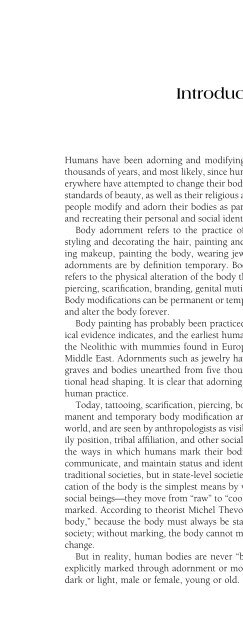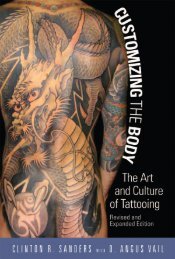- Page 2: Encyclopedia of Body Adornment
- Page 8: Library of Congress Cataloging-in-P
- Page 14: Acupuncture Alliance of Professiona
- Page 18: Scarification Self-Mortification Se
- Page 24: xii GUIDE TO RELATED TOPICS India I
- Page 28: xiv GUIDE TO RELATED TOPICS Interse
- Page 32: xvi PREFACE Nevertheless, all attem
- Page 38: INTRODUCTION xix The differential m
- Page 42: A ACUPUNCTURE Acupuncture is an anc
- Page 46: ALLIANCE OF PROFESSIONAL TATTOOISTS
- Page 50: AMERICAN TATTOOING 5 of their count
- Page 54: AMPUTATION 7 tattoo parlors, but a
- Page 58: ANIMAL BRANDING 9 selves be aligned
- Page 62: ANIMAL BRANDING 11 brand,” and br
- Page 66: ANIMAL SURGICAL PROCEDURES 13 Anima
- Page 70: ANIMAL TATTOOING 15 to standards, d
- Page 74: ASCETICISM 17 that comes with havin
- Page 78: AUSCHWITZ 19 See also: Alliance of
- Page 82: AUSTRALIA 21 During the circumcisio
- Page 88:
24 BARIATRIC SURGERY scarred, and e
- Page 92:
26 BDSM and torture by Chinese “t
- Page 96:
28 BEAUTY BEAUTY Beauty has both bi
- Page 100:
30 BIKER TATTOOING the use of nose
- Page 104:
32 BMEZINE.COM host of other locati
- Page 108:
34 BODYBUILDING were often displaye
- Page 112:
36 BODY HAIR Generally, people with
- Page 116:
38 BODY PAINTING In the late twenti
- Page 120:
40 BODY PIERCING into paint and the
- Page 124:
42 BODY PLAY Piercing studios, like
- Page 128:
44 BOURDIEU, PIERRE animals which h
- Page 132:
46 BRANDING Army deserters were bra
- Page 136:
48 BREAST AUGMENTATION AND REDUCTIO
- Page 140:
50 BREAST IRONING breast, exposing
- Page 144:
52 BROADBENT, BETTY Betty Broadbent
- Page 150:
C CASTRATION Castration generally r
- Page 154:
CASTRATION 57 While castration as a
- Page 158:
CHICANOS 59 souvenir tattoos. These
- Page 162:
CHRISTIANITY 61 or the body’s ene
- Page 166:
CHRISTIANITY 63 the designs. The mo
- Page 170:
CIRCUMCISION 65 also do not remove
- Page 174:
CIRCUS 67 Circumcision in the Unite
- Page 178:
See also: Freak Shows; Freaks; Tatt
- Page 182:
CLITORIDECTOMY 71 CLITORAL PIERCING
- Page 186:
CLITORIDECTOMY 73 where a woman who
- Page 190:
CONTEMPORARY TATTOOING 75 who would
- Page 194:
COOK, CAPTAIN JAMES 77 The traditio
- Page 198:
CORSETS 79 After the native people
- Page 202:
COSMETIC DENTISTRY 81 changes to th
- Page 206:
COSMETICS 83 earliest forms of make
- Page 210:
COSMETIC SURGERY 85 Of the voluntar
- Page 214:
CRIMINALITY 87 also branded with th
- Page 218:
CUTTING 89 of the design drawn. And
- Page 224:
92 DERMAL ANCHORING the form in whi
- Page 228:
94 EAR PIERCING ears to represent t
- Page 232:
96 EAR SHAPING New York: Fireside,
- Page 236:
98 EAR STRETCHING they emerged from
- Page 240:
100 EASTER ISLAND See also: Ear Pie
- Page 244:
102 ENCUMBERMENTS Wigs were initial
- Page 248:
104 ENGLAND Further Reading: Vale,
- Page 252:
106 THE ENIGMA See also: Celts; Coo
- Page 256:
108 ETHIOPIA indicates that a man h
- Page 260:
110 FACIAL PIERCING hair be removed
- Page 264:
112 FACIAL TATTOOS The nick piercin
- Page 268:
114 FINGERNAILS polishes to achieve
- Page 272:
116 FLESH COILS tattoos became clas
- Page 276:
118 FOUCAULT, MICHEL FOUCAULT, MICH
- Page 280:
120 FREAK SHOWS popular amusement i
- Page 284:
122 FREAKS “The Peerless Prodigie
- Page 288:
124 FREAKS birth of abnormal childr
- Page 292:
126 GAUNTLET One of the most popula
- Page 296:
128 GENDER In the West, too, we see
- Page 300:
130 GENITAL MUTILATION enhance the
- Page 304:
132 GENITAL PIERCING are temporaril
- Page 308:
134 THE GREAT OMI and I go get the
- Page 312:
136 GRECO-ROMAN WORLD GRECO-ROMAN W
- Page 318:
H HAIR CUTTING AND HEAD SHAVING Bec
- Page 322:
HAIRSTYLES 141 their heads when the
- Page 326:
HAIR TREATMENTS 143 The use of hair
- Page 330:
HARDY, DON ED 145 HAND PIERCING Han
- Page 334:
HAWAII 147 Hawaiian tattoos, at the
- Page 338:
HEAD BINDING 149 creating conventio
- Page 342:
HEALTH ISSUES 151 and a dirty spong
- Page 346:
HIJRAS 153 minus man.” Most hijra
- Page 352:
156 IMPLANTS A transdermal implant
- Page 356:
158 INDIA were tattooed prior to ma
- Page 360:
160 INTERSEXUALITY sewn together, i
- Page 364:
162 INUIT like most societies, is s
- Page 368:
164 ISLAM back to Pakistan told the
- Page 374:
J JAPAN Not only is Japanese tattoo
- Page 378:
It was also this same time period,
- Page 382:
JEWELRY 171 herbs or other magical
- Page 386:
JUDAISM 173 tattooed Jew can still
- Page 392:
176 LABRETS a sign of status. High-
- Page 396:
178 LEGISLATION AND REGULATION her
- Page 400:
180 LIP PLATES Lip plates are gener
- Page 404:
182 MAKEUP tattooed onto the knuckl
- Page 408:
184 MARSHALL ISLANDS still get tatt
- Page 412:
186 MESO-AMERICA skin, as in the ca
- Page 416:
188 MILITARY TATTOOS MILITARY TATTO
- Page 420:
190 MODERN PRIMITIVES Certain parts
- Page 424:
192 MODERN PRIMITIVES Further Readi
- Page 428:
194 MOKO Europeans. Evidently, it a
- Page 432:
196 MUSAFAR, FAKIR transformation,
- Page 436:
198 NATIVE AMERICANS Some tribes on
- Page 440:
200 NEW GUINEA Great Goddess. This
- Page 444:
202 NEW ZEALAND See also: Body Pain
- Page 448:
204 NOSE PIERCING My piercings help
- Page 452:
206 NOSE PIERCING Septum piercing w
- Page 456:
208 ORAL PIERCING Today, obesity ac
- Page 460:
210 ORCHIECTOMY be seen as decorati
- Page 464:
212 PAIN menstruation. Among the Tl
- Page 468:
214 PENIS PIERCING Samoan Pe’a ta
- Page 472:
216 PFIQ See also: Cosmetic Surgery
- Page 476:
218 PIERCING PIERCING The practice
- Page 480:
220 PRIMITIVISM Modern primitives,
- Page 484:
222 PRISON TATTOOING Prison tattoos
- Page 488:
224 PRISON TATTOOING man may wear a
- Page 492:
226 PRISON TATTOOING then serve to
- Page 496:
228 PUNK staples, and other sharp i
- Page 500:
230 ROMAN Each one of my tattoos wa
- Page 504:
232 ROMAN Phrases are also often ta
- Page 508:
234 SCALPELLING each part of the ta
- Page 512:
236 SCARIFICATION Among the Nuba of
- Page 516:
238 SELF-MORTIFICATION pieces of sk
- Page 520:
240 SEX REASSIGNMENT SURGERY pain,
- Page 524:
242 SIDESHOW SIDESHOW See Freak Sho
- Page 528:
244 SLAVERY Race and Affluence: An
- Page 532:
246 STALKING CAT ears, tongue, and
- Page 536:
248 STRETCHING of ways of stretchin
- Page 540:
250 SUPER/SUBINCISION SUPER/SUBINCI
- Page 544:
252 SUSPENSIONS Further Reading: ww
- Page 550:
T TAHITI Tahiti is a Polynesian isl
- Page 554:
TATTOO COMMUNITY 257 Sunbathing bec
- Page 558:
TATTOOED ATTRACTIONS 259 the develo
- Page 562:
TATTOOED ATTRACTIONS 261 Hildebrand
- Page 566:
TATTOOED NATIVES 263 James O’Conn
- Page 570:
TATTOOING 265 way for human odditie
- Page 574:
TATTOO MAGAZINES 267 While tattooin
- Page 578:
TATTOO MAGAZINES 269 both for tatto
- Page 582:
TATTOO REMOVAL 271 the stands calle
- Page 586:
TATTOO SHOWS 273 their wares, and t
- Page 590:
TATTOO TECHNOLOGY 275 For many indi
- Page 594:
THAILAND 277 Hearts and True Love:
- Page 598:
TIGHTLACING See Corsets TONGA 279 T
- Page 602:
TORTURE 281 Naked woman being tortu
- Page 606:
TRANSSEXUALS 283 Hijras cannot repr
- Page 610:
TREPANATION 285 women can so easily
- Page 614:
TRIBALISM 287 William H. Egberts ex
- Page 618:
TUTTLE, LYLE 289 at that time were
- Page 622:
W WAGNER, CHARLIE Professor Charles
- Page 626:
WILDENSTEIN, JOCELYN 293 WILDENSTEI
- Page 632:
296 YAKUZA the men often remove the
- Page 636:
298 ZEIS, MILTON See also: Scarific
- Page 642:
MAGAZINES Body Painting Magazine 14
- Page 646:
MUSEUMS Amsterdam Tattoo Museum htt
- Page 652:
306 BIBLIOGRAPHY Balsamo, Anne. “
- Page 656:
308 BIBLIOGRAPHY Davis, Kathy. Resh
- Page 660:
310 BIBLIOGRAPHY Gremillion, Helen.
- Page 664:
312 BIBLIOGRAPHY Lang, Sabine, Sue-
- Page 668:
314 BIBLIOGRAPHY Pitts, Victoria.
- Page 672:
316 BIBLIOGRAPHY Sullivan, Deborah.
- Page 678:
Acupuncture, 1-3, 60-61, 163 Afghan
- Page 682:
Ear spools and ear plugs, 48, 69, 9
- Page 686:
Lazonga, Vyvyn, 177-78 Leather comm
- Page 690:
Salmon, Bill, 146 Samoa, 75, 133, 1
- Page 694:
About the Author MARGO DEMELLO has
- Page 700:
Sacred heart shoulder tattoo. Jeff
- Page 704:
Skull on inner bicep. Jeff Hayes of
- Page 708:
Cartoon bunnies on woman’s chest.
- Page 712:
Photo-realistic tattoo of Albert Ei



